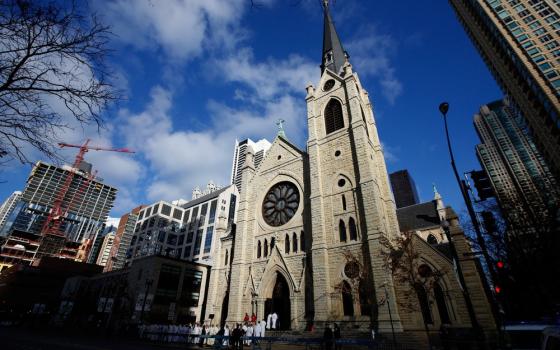BLIND SPOT: WHEN JOURNALISTS DON’T GET RELIGION
Edited by Paul Marshall, Lela Gilbert and Roberta Green Ahmanson
Published by Oxford University Press, $19.95
Foreign correspondents try to sort out the factions involved in violence in Iraq and India. Political writers analyze the approaches candidates take to reach faith groups in the United States. Film critics cover controversies involving movies about the life of Jesus.
Religion is a factor in most subjects covered by the news media, not only the once-a-week religion beat. Martin Marty, University of Chicago church historian, asks, “In the wake of Sept. 11, is there any news today that is not religion news?”
Despite the subject’s importance, its complexity sometimes baffles reporters to the extent that significant stories are ignored or misreported. Several scholars and commentators give examples and offer suggestions for overcoming the problem in Blind Spot: When Journalists Don’t Get Religion.
An extensive chapter is written by Michael Rubin, editor of Middle East Quarterly and a resident scholar at the American Enterprise Institute in Washington. In it, he shows how the Shiite movement that governs Iran has been mistakenly reported as normative of Shiites although it actually represents a minority. Other information he cites that many Persian Gulf correspondents are apparently unaware of includes the existence of about a dozen grand ayatollahs, all of whom have their followers, and a dispute over the starting date of Ramadan that has pitted Iranian Ayatollah Ali Khamenei against Iraq-based Grand Ayatollah Ali Sistani.
Allen D. Hertzke, professor of political science at the University of Oklahoma and author of Representing God in Washington, analyzes mainstream press coverage of the passage of the International Religious Freedom Act of 1998 and three other human-rights measures in which religious coalitions played crucial roles. He finds not only misreporting but sometimes inconsistent coverage even in the same outlet, such as The New York Times, “where a straightforward story is followed by a slanted one, an account of broader alliances by a story that exhibits a distorted Christian Right angle.”
In analyzing coverage of the death of Pope John Paul II and the early years of the pontificate of Benedict XVI, Catholic commentator Amy Welborn finds a lack of attention to controversies between John Paul and conservatives and little note of major theological writings of both popes. She says John Paul’s theology of the body, which has been the subject of university graduate programs, went largely unmentioned in U.S. media assessments of his legacy although it was included in Canadian and Australian assessments.
This observation indicates that the religion blind spot may be more a factor for U.S. journalists than those in other countries. In his chapter “Three Decades of Misreporting Iran and Iraq,” Rubin credits such media as Agence France-Presse and Financial Times with good coverage of stories that were missed or misunderstood by American correspondents.
While pointing out shortcomings in coverage of religion issues, the writers also credit the media for jobs well done and acknowledge the problems involved in covering such a complex subject for a general audience.
In a chapter analyzing coverage of religion issues in the 2004 U.S. presidential campaign, political scientists C. Danielle Vinson and James L. Guth note, “The great variety of faith traditions, the internal divisions within each, and other nuances of religion itself make good reporting difficult.” Among suggestions for improving the situation, the writers offer such standard nostrums as diversifying newsroom staffs, providing more opportunities for training in religion issues, and appreciating the importance of religion as a factor in today’s world.
Based on the critiques offered in the book, other good practices might include letting an in-house specialist review stories written by other journalists that have a prominent faith angle and regularly checking blogs that report religion well, such as Reuters’ FaithWorld (blogs.reuters.com/faithworld), and those that critique religion reporting, such as GetReligion.org. Such efforts, possible in newsrooms of every size, can help to remove the blind spot.
Darrell Turner writes the regular religion section for the Encyclopedia Britannica.
National Catholic Reporter February 6, 2009



